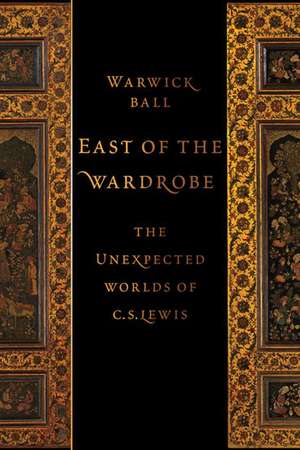East of the Wardrobe: The Unexpected Worlds of C. S. Lewis
Autor Warwick Ballen Limba Engleză Hardback – 22 sep 2022
Preț: 168.59 lei
Preț vechi: 193.38 lei
-13% Nou
Puncte Express: 253
Preț estimativ în valută:
32.26€ • 33.33$ • 26.84£
32.26€ • 33.33$ • 26.84£
Carte disponibilă
Livrare economică 15-21 februarie
Livrare express 12-18 februarie pentru 53.06 lei
Preluare comenzi: 021 569.72.76
Specificații
ISBN-13: 9780197626252
ISBN-10: 0197626254
Pagini: 320
Ilustrații: 55 b/w halftones; 5 b/w line illustrations
Dimensiuni: 203 x 137 x 31 mm
Greutate: 0.48 kg
Editura: Oxford University Press
Colecția OUP USA
Locul publicării:New York, United States
ISBN-10: 0197626254
Pagini: 320
Ilustrații: 55 b/w halftones; 5 b/w line illustrations
Dimensiuni: 203 x 137 x 31 mm
Greutate: 0.48 kg
Editura: Oxford University Press
Colecția OUP USA
Locul publicării:New York, United States
Recenzii
"a complex, wide-ranging investigation" -- Mark Vernon, Church Times
Ball's work highlights the breadth of intellectual and cultural traditions that were available to writers of his generation.
The book's personal, digressive, and allusive qualities make it a page turner and often sheer fun to read.
A highly enjoyable and eye-opening account of the myriad ways Lewis was influenced by Eastern art, literature, and philosophy - and, indeed, religion.
The book's personal, digressive, and allusive qualities make it a page turner and often sheer fun to read... Even those readers who are simply interested in comparative literature can enjoy the numerous possibilities on display. I think East of the Wardrobe will be mined for all of these for some years to come.
East of the Wardrobe is as enjoyable as it is important...Laced with Ball's humour and humanity, this book has something for every reader.
East of the Wardrobe is as enjoyable as it is important. Ball betrays intimate familiarity with the Chronicles, undertaking close-reading (even exegesis) of the texts that will delight Narnia fans. Theologians will be fascinated by the variety of Eastern concepts evident in books whose secrets were thought to be long revealed... Even the endnotes were amusing and intriguing, with many meriting footnote status. C. S. Lewis emerges as a more complex and sympathetic author than commonly understood, whose bibliophilia sparked a love of beautiful stories, regardless of provenance. Laced with Ball's humour and humanity, this book has something for every reader.
This book's uniqueness arises most of all from the extent of the author's knowledge of Eastern, primarily but not limited to Eastern Mediterranean and Near Eastern, locations and texts. It makes a valuable contribution to the recognition, understanding, and appreciation of Lewis's interest in and use of Eastern matters.
C.S. Lewis had read widely in travel accounts of the Near and Middle East. Warwick Ball's sensitive, humane and often humorous book shows how Lewis' learning enriched and helped to universalize the fundamentally Christian worldview of the Narnia books. The author's own fine photographs also deepen one's appreciation of the illustrator Pauline Baynes' evocation of Lewis' fantasy cityscapes. One looks on the Calormenes and Marshwiggles with new eyes.
East of the Wardrobe brings an important new lens to the topic of Narnia and its roots.... Provide[s] a rich array of links between the East and Narnia.
Ball's work highlights the breadth of intellectual and cultural traditions that were available to writers of his generation.
The book's personal, digressive, and allusive qualities make it a page turner and often sheer fun to read.
A highly enjoyable and eye-opening account of the myriad ways Lewis was influenced by Eastern art, literature, and philosophy - and, indeed, religion.
The book's personal, digressive, and allusive qualities make it a page turner and often sheer fun to read... Even those readers who are simply interested in comparative literature can enjoy the numerous possibilities on display. I think East of the Wardrobe will be mined for all of these for some years to come.
East of the Wardrobe is as enjoyable as it is important...Laced with Ball's humour and humanity, this book has something for every reader.
East of the Wardrobe is as enjoyable as it is important. Ball betrays intimate familiarity with the Chronicles, undertaking close-reading (even exegesis) of the texts that will delight Narnia fans. Theologians will be fascinated by the variety of Eastern concepts evident in books whose secrets were thought to be long revealed... Even the endnotes were amusing and intriguing, with many meriting footnote status. C. S. Lewis emerges as a more complex and sympathetic author than commonly understood, whose bibliophilia sparked a love of beautiful stories, regardless of provenance. Laced with Ball's humour and humanity, this book has something for every reader.
This book's uniqueness arises most of all from the extent of the author's knowledge of Eastern, primarily but not limited to Eastern Mediterranean and Near Eastern, locations and texts. It makes a valuable contribution to the recognition, understanding, and appreciation of Lewis's interest in and use of Eastern matters.
C.S. Lewis had read widely in travel accounts of the Near and Middle East. Warwick Ball's sensitive, humane and often humorous book shows how Lewis' learning enriched and helped to universalize the fundamentally Christian worldview of the Narnia books. The author's own fine photographs also deepen one's appreciation of the illustrator Pauline Baynes' evocation of Lewis' fantasy cityscapes. One looks on the Calormenes and Marshwiggles with new eyes.
East of the Wardrobe brings an important new lens to the topic of Narnia and its roots.... Provide[s] a rich array of links between the East and Narnia.
Notă biografică
Warwick Ball is an archaeologist who has carried out excavations, architectural studies, and monumental restoration in Afghanistan, Iran, Iraq, Jordan, Libya, and Ethiopia. His previous books include Syria: An Architectural and Historical Guide, The Monuments of Afghanistan, Archaeological Gazetteer of Afghanistan, The Archaeology of Afghanistan, The Eurasian Steppe: People, Movement, Ideas, and Rome in the East: The Transformation of an Empire, winner of the James Henry Breasted History Prize.
